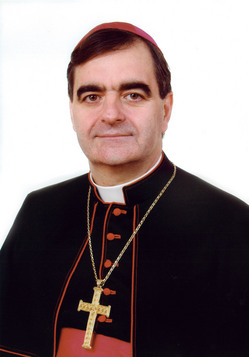Last week you might remember a note on the secretary general of the Synod of Bishops, Archbishop Nikola Eterovic, addressing the American Bible Society and friends in NYC on Tuesday, 28 July.
Tag: scripture
A second look at the bishops’ work on the Bible with Nikola Eterovic
His Excellency, the Most Reverend Nikola Eterovic, Secretary General of the Synod of Bishops, Vatican City State, will deliver a talk titled “Pope Benedict XVI, the Bible and the Synod of Bishops.”
The archbishop will review the seminal work of the of the world-wide gathering of bishops and other experts on the Word of God which happened in October 2008.
The talk is sponsored by the American Bible Society and is being presented at their NY Offices.
Details:
Date: Tuesday, July 28, 2009
Time: 6:30-7:30 p.m.
Location: The American Bible Society
1865 Broadway (between 61st & 62nd Streets) New York, NY 10023
RSVP Alicia DeFrange at 212-408-1260 or by emai adefrange@americanbible.org
Ark of the Covenant to revealed
The
head of the Ethiopian Orthodox Church, Abuna Pauolos, is set to unveil the Ark
of the Covenant. The Ark of the Covenant has been in the guardianship of the
Ethiopian Orthodox Church in a chapel in the Church of Our Lady, Mary of Zion.
But with many religious icons and relics the Ark has been claimed by a number of
people over the years, some credible and many not so believable. There is no reason I know of to doubt the authenticity of the Ark that’s with the Patriarch.
We don’t hear
much of the Ark of Covenant today except for intro Scripture classes; however,
it should be noted that the Ark is a unit of learning in the Catechesis of the
Good Shepherd (a catechetical program for little people developed around a
Montessori method). The relevance of the Ark, you will remember, is that it was
God’s command that the Ark be built to contain the tablets of the Decalogue
(the 10 Commandment), Aaron’s rod and manna. On the theological level the Ark
is emblematic of the Covenant God had with His people (Israel). Today, a
theology of Covenant continues but not in tablets or an Ark but in a
Person–Jesus Christ. Catholics honor and follow the 10 Commandments; we honor the
Ark but we worship neither. We adore, worship, and give glory to a God who
became a flesh and blood person, a man in all things like you and me except
sin; the Son of God who opened the doors of salvation for us. Catholics
believe, therefore, our salvation is not in the Commandments but from Christ
who lived, died, and resurrected. As I mentioned the Commandments are followed
and we revere the Ark so long as we recognize that they point to their fulfillment in Jesus. So learn about the Ark and pass this theology onto your
friends and family.
THE smallest gift for the Pope: A grain of sand contains the Hebrew Bible

In this photo taken April 26, is a chip containing the entire Hebrew Bible at the Technion University in Haifa. During a May 11 reception at the residence of Israel’s president, Shimon Peres, Benedict XVI will receive this 300,000-word Hebrew text of the Jewish Bible inscribed on a silicon particle the size of a grain of sand, using nanotechnology. The chip is read through a microscope which makes it a tad difficult for lectio and proclamation in a synagogue or a church.
Only within the heart of the Church is the Word of God authentic, Pope Benedict says
The Pontifical Biblical Commission (PBC) during their annual plenary assembly this week has been working on the theme of “Inspiration and Truth in the Bible,” as a result of the October 2008 synod of bishops on the Word of God.
In his address to the PBC the Pope spoke of the importance of sacred Scripture because it “concerns not only believers, but the Church herself, because the Church’s life and mission necessarily rest upon the Word of God, which is the soul of theology and, at the same time, the inspiration of all of Christian life…the interpretation of sacred Scripture is of vital importance for Christian faith and for the life of the Church.”
According to the Holy Father: “From a correct approach to the concept of divine inspiration and truth in sacred Scripture derive certain norms that directly concern its interpretation. The Constitution Dei Verbum, having affirmed that God is the author of the Bible, reminds us that in sacred Scripture God speaks to mankind in a human manner. For a correct interpretation of Scripture we must, then, carefully examine what the hagiographers really sought to say and what God was pleased to reveal with their words.”
Drawing his remarks from the Second Vatican Council, the Pope reminded the PBC –and us– that are “three perennially valid criteria for interpreting sacred Scripture in accordance with the Spirit that inspired it. In the first place, great attention must be given to the content and unity of the whole of Scripture. Indeed, however different the books it contains may be, sacred Scripture is one by virtue of the unity of God’s plan, of which Jesus Christ is the center and the heart. In the second place, Scripture must be read in the context of the living tradition of the entire Church [because tradition] carries the living memory of the Word of God, and it is the Holy Spirit who provides her with the interpretation thereof in accordance with its spiritual meaning. The third criterion concerns the need to pay attention to the analogy of the faith; that is, to the cohesion of the individual truths of faith, both with one another and with the overall plan of Revelation and the fullness of the divine economy enclosed in that plan.
Thinking with the Church the work of scholars, in the mind of the mind of the Holy Father, is to “contribute, following the above-mentioned principles, to a more profound interpretation and exposition of the meaning of sacred Scripture. The academic study of the sacred texts is not by itself sufficient. In order to respect the coherence of the Church’s faith, Catholic exegetes must be careful to perceive the Word of God in these texts, within the faith of the Church. The interpretation of sacred Scriptures cannot be merely an individual academic undertaking, but must always be compared with, inserted into, and authenticated by the living tradition of the Church. This norm is essential in order to ensure a correct and reciprocal exchange between exegesis and Church magisterium. Catholic exegetes do not nourish the individualistic illusion that biblical texts can be better understood outside the community of believers. The opposite is true, because these texts were not given to individual scholars ‘to satisfy their curiosity or to provide them with material for study and research.’ The texts inspired by God were entrusted to the community of believers, to the Church of Christ, to nourish the faith and to guide the life of charity. Sacred Scripture is the Word of God in that is written down under the inspiration of the Holy Spirit. Tradition, on the other hand, integrally transmits the Word of God as entrusted by Christ the Lord and by the Holy Spirit to the Apostles and their successors so that they, illuminated by the Spirit of truth, could faithfully conserve, explain and spread it through their preaching. Only within the ecclesial context, can Sacred Scripture be understood as the authentic Word of God which is the guide, norm and rule for the life of the Church and the spiritual development of believers.”
If this is certain, then it means “rejecting all interpretations that are subjective or limited to mere analysis [and therefore] incapable of accepting the global meaning which, over the course of the centuries, has guided the Tradition of the entire people of God.”
The Word of God in the Life and Mission of the Church
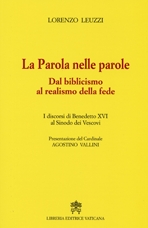 Only a few months after the 12th General Assembly of the Synod of Bishops on The Word of God in the Life and Mission of the Church (in Italian now), Vatican Radio hosted the book launch of The Word in words: From Biblicism to the realism of the faith. Written by Monsignor Lorenzo Leuzzi, director of the Office for Pastoral Care of Universities of the vicariate of
Only a few months after the 12th General Assembly of the Synod of Bishops on The Word of God in the Life and Mission of the Church (in Italian now), Vatican Radio hosted the book launch of The Word in words: From Biblicism to the realism of the faith. Written by Monsignor Lorenzo Leuzzi, director of the Office for Pastoral Care of Universities of the vicariate of
“The most important thing is to help the Church rediscover the presence of the Word — to see that the Church is not the only place Scripture is to be read, but is the place where man can truly find God through Scripture in a greater experience. Because the Word is not just in the Scriptures, but the Word is present in history.”
“I’m happy to acknowledge with gratitude that there are many young people who, through the Bible, deepen their faith in God — One in Three, Father, Son, and Holy Spirit — because in the words of the Bible they discover the Word that is Jesus Christ, who leads us to adore God the Father, with the grace that the Holy Spirit offers us in abundance.”
Pope Benedict speaks on Saint Bede
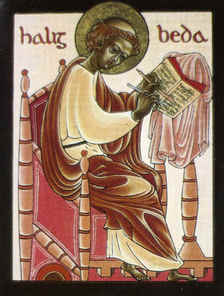 The saint on whom we reflect today is called Bede. He was born in
The saint on whom we reflect today is called Bede. He was born in
 Sacred Scriptures were the constant source of Bede’s theological reflection. Having made a careful critical study of the text (we have a copy of the monumental Codex Amiatinus of the Vulgate, on which Bede worked), he commented on the Bible, reading it in a Christological vein, namely, re-uniting two things: On one hand, he listened to what the text was saying exactly, he really wanted to listen and understand the text itself; on the other hand, he was convinced that the key to understanding sacred Scripture as the unique Word of God is Christ and with Christ, in his light, one understands the Old and the New Testament as “a” sacred Scripture.
Sacred Scriptures were the constant source of Bede’s theological reflection. Having made a careful critical study of the text (we have a copy of the monumental Codex Amiatinus of the Vulgate, on which Bede worked), he commented on the Bible, reading it in a Christological vein, namely, re-uniting two things: On one hand, he listened to what the text was saying exactly, he really wanted to listen and understand the text itself; on the other hand, he was convinced that the key to understanding sacred Scripture as the unique Word of God is Christ and with Christ, in his light, one understands the Old and the New Testament as “a” sacred Scripture.
The events of the Old and New Testament go together, they are together the path toward Christ, though expressed in different signs and institutions (it is what he calls “concordia sacramentorum”). For example, the tent of the covenant that Moses raised in the desert and the first and second
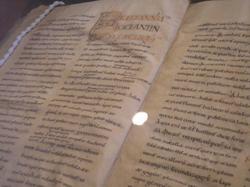 Another topic loved by Bede is the history of the Church. After having taken interest in the period described in the Acts of the Apostles, he reviewed the history of the Fathers of the Church and the councils, convinced that the work of the Holy Spirit continues in history. In the Cronica Maiora, Bede traces a chronology that would become the basis of the universal calendar “ab incarnatione Domini.” Up to then, time was calculated from the foundation of the city of
Another topic loved by Bede is the history of the Church. After having taken interest in the period described in the Acts of the Apostles, he reviewed the history of the Fathers of the Church and the councils, convinced that the work of the Holy Spirit continues in history. In the Cronica Maiora, Bede traces a chronology that would become the basis of the universal calendar “ab incarnatione Domini.” Up to then, time was calculated from the foundation of the city of
Bede was also an illustrious teacher of liturgical theology. In the homilies on the Sunday Gospels and those of feast days, he develops a true mystagogy, educating the faithful to celebrate joyfully the mysteries of the faith and to reproduce them consistently in life, while expecting their full manifestation of the return of Christ, when, with our glorified bodies, we will be admitted in offertory procession to the eternal liturgy of God in heaven. Following the “realism” of the catecheses of Cyril, Ambrose and Augustine, Bede teaches that the sacraments of Christian initiation make every faithful person “not only a Christian but Christ.” In fact, every time that a faithful soul receives and guards the Word of God with love, in imitation of Mary, he conceives and generates Christ again. And every time that a group of neophytes receives the Easter sacraments, the Church is “self-generated,” or to use a still more daring expression, the Church becomes “Mother of God,” participating in the generation of her children, by the work of the Holy Spirit.
Thanks to this way of making theology, interlacing the Bible, the liturgy and history, Bede has a timely message for the different “states of life”:
a) For scholars (doctores ac doctrices) he recalls two essential tasks: to scrutinize the wonders of the Word of God to present it in an attractive way to the faithful; to show the dogmatic truths avoiding the heretical complications and keeping to the “Catholic simplicity,” with attention to the small and humble to whom God is pleased to reveal the mysteries of the Kingdom.
b) For pastors, that for their part, must give priority to preaching, not only through the verbal or hagiographic language, but also valuing icons, processions and pilgrimages. Bede recommends to them the use of the vernacular, as he himself does, explaining in
c) For consecrated people who are dedicated to the Divine Office, living in the joy of fraternal communion and progressing in the spiritual life through ascesis and contemplation, Bede recommends to take care of the apostolate — no one has the Gospel just for himself, but must regard it as a gift also for others — either by collaborating with the Bishops in pastoral activities of various types in favor of the young Christian communities, or being available to the evangelizing mission to the pagans, outside their own country, as “peregrini pro amore Dei.”
Placed in this perspective, in the commentary to the Canticle of Canticles, Bede presents the synagogue and the Church as collaborators in the propagation of the Word of God. Christ the Spouse desires an industrious Church, “bronzed by the fatigues of evangelization” — clear is the reference to the word of the Canticle of Canticles (1:5), where the Bride says: “Nigra sum sed formosa” (I am brown, but beautiful) — attempts to till other fields or vines and to establish among the new populations “not a provisional bell but a stable dwelling, namely, to insert the Gospel in the social fabric and the cultural institutions. In this perspective, the saintly Doctor exhorts the lay faithful to be assiduous to the religious instruction, imitating those “insatiable evangelical multitudes who did not even give the Apostles time to eat.” He teaches them how to pray constantly, “reproducing in life what they celebrate in the liturgy,” offering all actions as spiritual sacrifices in union with Christ. To parents he explains that also in their small domestic realm they can exercise “the priestly office of pastors and guides,” by giving Christian formation to the children and states that he knows many faithful (men and women, spouses and celibates) “capable of an irreproachable conduct that, if suitably pursued, could approach daily Eucharistic communion (“Epist. ad Ecgbertum,” ed. Plummer, p. 419).
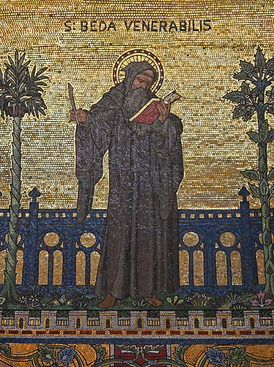 The fame of holiness and wisdom that Bede enjoyed already in life, served to merit him the title of “Venerable.” He is thus called also by Pope Sergius I, when he wrote his abbot in 701 requesting to make him come temporarily to
The fame of holiness and wisdom that Bede enjoyed already in life, served to merit him the title of “Venerable.” He is thus called also by Pope Sergius I, when he wrote his abbot in 701 requesting to make him come temporarily to
Let us pray that also today there be personalities of Bede’s stature, to keep the whole Continent united; let us pray so that all of us are willing to rediscover our common roots, to be builders of a profoundly human and genuinely Christian Europe.
(Wednesday General Audience, Rome, 18 February 2009)
The encounter with Christ?
Basilian Father Thomas Rosica, in his weekly article on the forthcoming Sunday Scriptures, “To What Lengths Are We Willing to Go to Encounter Jesus?” asks:
Do we share the paralytic man’s faith in today’s Gospel? Do we have the chutzpah, creativity, perseverance and persistence of his friends to bring someone to Christ? To what lengths are we willing to go to encounter Jesus? How much are we willing to sacrifice so that our friends, too, might hear his saving word and experience the Lord’s healing touch and presence?
Find the article here.
AND the answer is? What does your time doing Lectio Divina reveal to you?
Beginnings, translations and God’s Plans
Rusty Reno tackles the question of where to begin when considering our life in God in his First Things essay, “In The Beginning.” Reno provokes me to ask a few questions. Where do we begin, when, why and for what purpose? What is our destiny, in other words? Where do our loyalties exist? Are we wedded too much to our ideas? That is, are we blinded to a particular theological lens and biblical interpretation that when truth is presented we pass it by because we are too comfortable in our belief system? If we are rigidly following what we think is right versus wrong will we ever advance in wisdom, grace and love? AND the problem is thus exposed: who’s wisdom, grace and love are living in? God’s or ours? What place does Torah and the Gospel have in our lives? Do we follow a political personality or Jesus, the Savior?
Father Julián Carrón & Carl Anderson speak about the Synod of Bishops
Last evening (19 January) two participants in the October 2008 Synod of Bishops spoke about the importance and value of knowing Christ personally and intimately. Christ is not an abstraction nor is Christianity an ethic. Merely knowing about Jesus is moralistic and inconsistent with the true experience of Christinity which says that Jesus Christ is the true, personal foundation of life and that He answers the need of heart. Father Julián Carrón, President of the Fraternity of Communion & Liberation and Mr. Carl Anderson, Supreme Knight of the Knights of Columbus addressed a crowd of more than 200 people, including the Most Reverend Peter A. Rosazza, an auxiliary bishop of Hartford and Vicar for New Haven, CT. The evening was moderated by Dominican Father Peter John Cameron, Editor-in-Chief of Magnificat magazine.
The discussion was built on the theme “The Word’s Face: The Word of God in the Life and Mission of Every Believer.” Saint Mary’s Church Hall (New Haven, CT) was the venue of the evening. This was the same hall that the Venerable Servant of God Michael J. McGivney founded the Knights of Columbus in 1882.
The discussion emphasized that Christians are not a people of the Book, as is commonly but wrongly asserted, but a people who follow a person, the definitive revelation of God, Jesus Christ. Moreover, it was emphasized that Catholics know Christ through sacred Scripture and Tradition. Anderson made a point in saying that he had heard a story of someone facing imprisonment who given a choice in taking one book with him and he selected the missal. The reasoning was the missal had both Scripture and the Liturgy. Both Anderson and Carrón dealt with various aspects of Dei Verbum, the revolutionary document on Divine Revelation from the Second Vatican Council. Anderson made a point that the Church is missionary in sharing the faith with others and noted that Pope Paul VI, Pope John Paul II and Pope Benedict XVI have made the effective preaching of Jesus Christ a particularly important aim of the entire Church, each according to his or her place in the Body of Christ.
Father Julián Carrón was an Ordinary member of the Synod meaning that he was a full and voting participant in the Synod as the bishops who are appointed to the gathering. Father Carrón’s Synodal intervention can be read here. Mr. Anderson was an auditor at the Synod meaning that he was a partial participant at the Synod but less important as his role was to listen to the work of the Synodal Fathers, to meet experts and those participating in the Synod and to make brief intervention before the full body of the Synod. Both have participated in previous Synods of Bishops.
Father Carrón and Mr. Anderson answered questions fielded from the audience and afterwards met with anyone who presented themselves. Father Carrón met very briefly with members of the local members of the Communion & Liberation. The event was an experience of Christ among us.
The evening was sponsored by Communion & Liberation of Connecticut, the Supreme Council of the Knights of Columbus and Saint Mary’s Church & Priory.
A brief article and video of the panel discussion can be found here.
